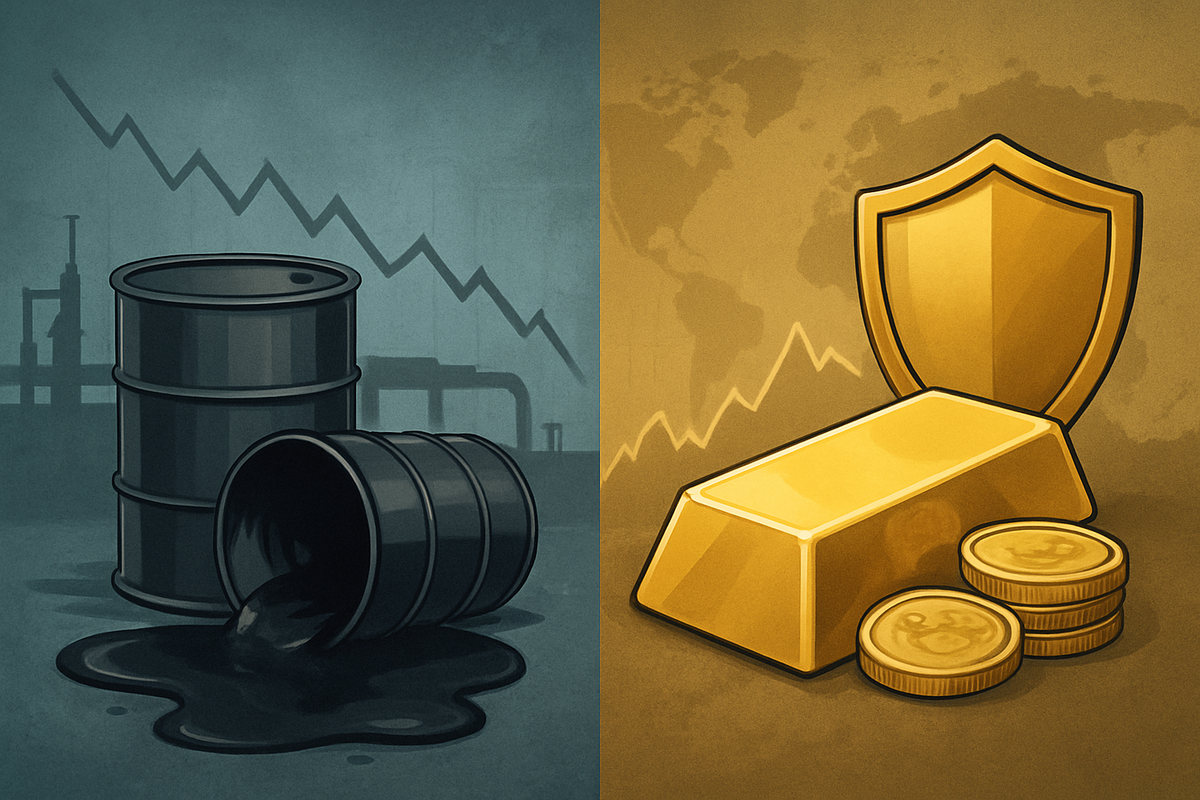
As global markets brace for an uncertain future, the twin pillars of the commodity world—oil and gold—are telling divergent tales on November 6, 2025. Crude oil prices are experiencing a notable downturn, driven by a confluence of oversupply concerns and weakening global demand, signaling potential economic headwinds. Conversely, gold prices are enjoying a robust rally, fueled by a pervasive "risk-off" sentiment, geopolitical turbulence, and sustained central bank accumulation, underscoring its enduring appeal as a safe-haven asset amidst widespread anxieties.
The immediate implications of these contrasting trends are significant. For oil-importing nations and sectors, lower crude prices offer a potential reprieve from inflationary pressures and improved fiscal health. However, for oil-exporting economies and energy producers, the subdued price environment poses considerable challenges to revenues and investment. Meanwhile, gold's ascent reflects deep-seated investor apprehension, suggesting a re-evaluation of risk in portfolios and a flight towards capital preservation, which could impact equity markets and broader economic stability.
Oil's Bearish Turn and Gold's Golden Glow: A Deep Dive into Market Dynamics
The current landscape for crude oil, as of November 6, 2025, is decidedly bearish. West Texas Intermediate (WTI) crude is hovering around $59.60 to $60.10 per barrel, while Brent crude trades between $63.52 and $64.03 per barrel. Both benchmarks have seen declines of approximately 2-3% over the past month and a more substantial 15-17% drop compared to a year ago. This slump follows a period of stability on November 6th, which saw a slight rebound in the European session after two days of declines, yet prices remain near two-week lows.
The timeline leading to this moment has been characterized by growing fears of an oil glut. Increased production from both OPEC+ nations and non-member countries like Canada and Kazakhstan has exacerbated oversupply concerns. While OPEC+ approved a modest output increase for December, plans to pause further hikes in early 2026 reflect their acknowledgment of weakening demand. Projections from Mercuria Energy Trading, a key player in global energy markets, suggest the oil market oversupply could reach a staggering 2 million barrels per day in 2026. Simultaneously, disappointing manufacturing PMIs from Asia and the US, alongside subdued US consumption and moderating demand growth from China due to accelerated electric vehicle adoption, have dampened the global demand outlook. Unexpected surges in US crude inventories, such as a recent increase of 5.202 million barrels, further underscore this fading demand. Geopolitical factors have offered mixed signals; while Ukrainian strikes on Russian oil refineries temporarily eased oversupply concerns, broader geopolitical tensions continue to introduce uncertainty.
In stark contrast, gold prices on November 6, 2025, are exhibiting a slight upward trend, trading near $3,986 an ounce globally. This follows a period of significant volatility, including an all-time high of $4,381.58 per troy ounce in October 2025, followed by a correction and subsequent renewed buying interest. The primary driver for gold's strength is a pervasive "risk-off" sentiment across global financial markets. Persistent economic uncertainties, geopolitical turbulence, and concerns over inflated equity valuations are pushing investors towards gold's traditional safe-haven appeal. A weakening US dollar, the currency in which gold is denominated, also makes the precious metal more attractive to international buyers. Lingering inflationary expectations and consistent accumulation by global central banks, particularly those in emerging markets, further bolster gold's position. The ongoing US government shutdown adds another layer of economic uncertainty, fueling safe-haven demand.
Corporate Fortunes: Winners and Losers in the Commodity Shift
The divergent paths of oil and gold prices are poised to create distinct winners and losers across various industries and public companies. For the oil sector, the subdued price environment presents significant challenges. Major integrated oil and gas companies like ExxonMobil (NYSE: XOM) and Chevron (NYSE: CVX) could see pressure on their upstream exploration and production revenues, potentially impacting profitability and capital expenditure plans. Smaller independent producers, often with higher production costs, face even greater headwinds, with some potentially struggling to maintain operations or service debt. Oilfield service companies such as Schlumberger (NYSE: SLB) and Halliburton (NYSE: HAL) might experience reduced demand for their services as producers cut back on drilling and exploration activities. Conversely, companies involved in oil refining and downstream operations, like Marathon Petroleum (NYSE: MPC) and Valero Energy (NYSE: VLO), could benefit from lower input costs, leading to improved margins, provided demand for refined products remains stable. Airlines, shipping companies, and other industries with high fuel consumption, such as Delta Air Lines (NYSE: DAL) and United Parcel Service (NYSE: UPS), are poised to gain from reduced operating expenses, potentially boosting their bottom lines.
On the gold front, mining companies are clear beneficiaries of rising prices. Major gold producers like Barrick Gold (NYSE: GOLD), Newmont Corporation (NYSE: NEM), and Agnico Eagle Mines (NYSE: AEM) are likely to see increased revenue and profitability from their operations. Higher gold prices improve the economics of existing mines and can make previously uneconomical reserves viable, potentially leading to increased exploration and development activities. Companies specializing in gold streaming and royalties, such as Franco-Nevada (NYSE: FNV), also stand to gain significantly as their income streams are directly tied to the price of gold. Furthermore, financial institutions and investment funds with substantial holdings in gold or gold-backed exchange-traded funds (ETFs) will see their asset values appreciate. Conversely, industries heavily reliant on discretionary consumer spending, particularly in regions with strong cultural ties to gold like India, might see a shift in consumer behavior. High gold prices could dampen demand for new jewelry, potentially impacting retailers, while simultaneously stimulating the second-hand gold market.
Wider Significance: A Barometer of Global Economic Health
These contrasting commodity trends carry wider significance, serving as a critical barometer of global economic health and investor sentiment. The sustained weakness in oil prices, driven by oversupply and diminishing demand, fits into a broader industry trend of heightened scrutiny on energy transition and the long-term viability of fossil fuels. While short-term oversupply is a key factor, the moderating demand growth in China due to accelerated EV adoption highlights a structural shift that could have profound long-term implications for oil-dependent economies and energy companies. The potential ripple effects include reduced investment in new oil projects, which could lead to supply shortages in the distant future if demand doesn't decline as rapidly as production cuts. Regulatory bodies worldwide are increasingly focused on climate change initiatives, which could further disincentivize fossil fuel investments and accelerate the transition away from oil. Historically, prolonged periods of low oil prices have often preceded or accompanied global economic slowdowns, offering a cautionary tale.
Gold's robust performance, on the other hand, underscores a deep-seated global "risk-off" sentiment that extends beyond immediate economic data. It reflects concerns over persistent inflation, the stability of fiat currencies, and geopolitical fragmentation. This trend aligns with increased central bank diversification away from the US dollar, a move that gained traction after various geopolitical and economic shocks in recent years. The ongoing US government shutdown further amplifies this uncertainty, pushing investors towards assets perceived as safe havens. The sustained demand for gold suggests that despite efforts by central banks to manage inflation, underlying anxieties about economic stability and currency debasement persist. This could lead to a broader reallocation of capital away from riskier assets like equities and into more defensive holdings. The historical precedent for gold rallies during times of economic and political instability is well-established, reinforcing its role as a crisis hedge.
What Comes Next: Navigating Volatility and Strategic Shifts
Looking ahead, the short-term outlook for oil suggests continued volatility. While oversupply concerns are dominant, geopolitical flashpoints, such as ongoing conflicts in the Middle East and the Russia-Ukraine war, retain the potential to disrupt supply chains and trigger sudden price spikes. The actions of OPEC+ will be crucial; any unexpected deviations from their stated production plans could significantly impact market sentiment. For oil companies, strategic pivots towards cost efficiency, diversification into renewable energy sources, and consolidation within the industry may become more prevalent. Market opportunities could emerge for companies adept at navigating a low-price environment through technological innovation or by acquiring distressed assets. The long-term trajectory for oil will be heavily influenced by the pace of the global energy transition and the effectiveness of climate policies.
For gold, the immediate future appears bright, sustained by ongoing geopolitical uncertainties, inflationary concerns, and the likelihood of continued central bank accumulation. However, gold's sensitivity to monetary policy means that any unexpected hawkish shifts from major central banks, particularly the US Federal Reserve, could temper its rally. Potential strategic adaptations for investors include maintaining a diversified portfolio with an appropriate allocation to gold as a hedge against market volatility and inflation. Market challenges could arise if global economic stability unexpectedly improves, reducing safe-haven demand. Potential scenarios include gold continuing its ascent if global uncertainties persist, or a correction if economic conditions stabilize and interest rate expectations shift. Investors should closely monitor central bank communications, geopolitical developments, and inflation data for cues.
Wrap-Up: A Market in Flux
In summary, the commodity markets as of November 6, 2025, present a compelling narrative of divergence. Oil prices are grappling with a significant oversupply and weakening global demand, signaling potential economic slowdowns and posing challenges for producers while benefiting importers. Gold, conversely, is thriving amidst a backdrop of global uncertainty, inflationary concerns, and robust safe-haven demand, reaffirming its role as a crucial store of value.
Moving forward, the market is poised for continued flux. Investors should closely watch OPEC+ decisions, global economic indicators, and geopolitical developments for their impact on oil prices. For gold, central bank policies, inflation trends, and the overall risk appetite of investors will be key determinants. The contrasting performances of these two vital commodities highlight the complex and often contradictory forces shaping the global financial landscape. Understanding these dynamics is paramount for navigating the opportunities and challenges that lie ahead.
This content is intended for informational purposes only and is not financial advice





